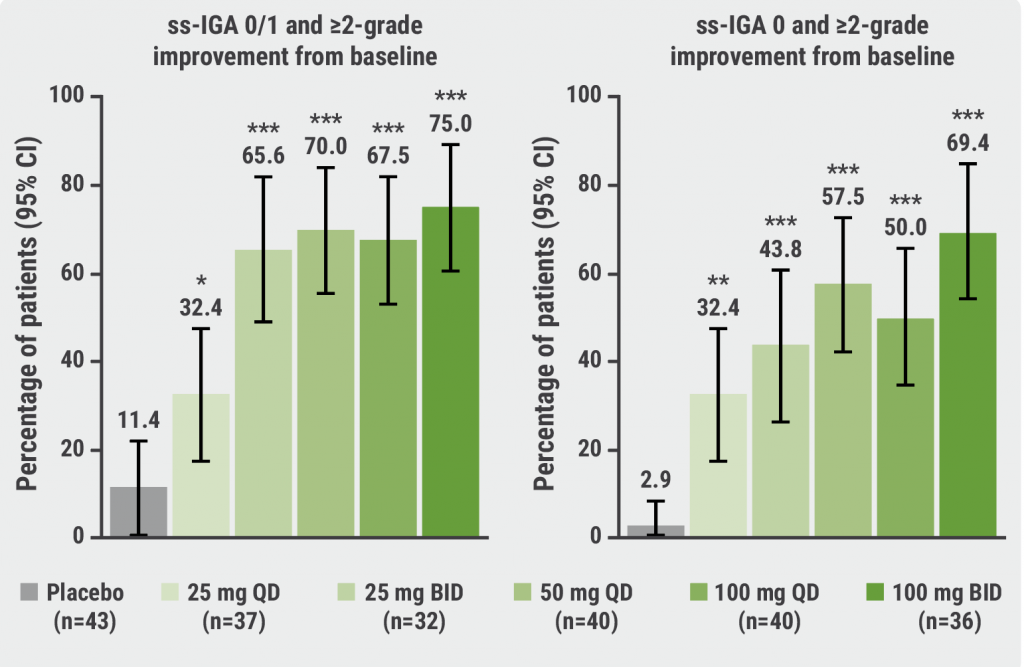Itch is the moth bothersome symptom for patients with AD most and it is furthermore associated with sleep loss, reduced quality of life, and reduced productivity. “With our analysis, we wanted to find out how long it will take to relieve itch. This is especially interesting in comparison with JAK inhibitors,” said Prof. Eric Simpson (Oregon Health & Science University, USA). The LIBERTY AD ADOL trial included 251 adolescent patients (aged 12 to 18 years). They were randomised to subcutaneous dupilumab every 2 weeks in 2 dosages according to body weight (< 60 kg or ≥ 60 kg), dupilumab every 4 weeks, or placebo over 16 weeks. The co-primary endpoints of the study were: percentage of participants with almost clear or clear skin according to the Investigator Global Assessment (IGA) score (0/1 score) and reduction from baseline of ≥ 2 points, and percentage of patients with an improvement of the EASI score by 75%. These endpoints were met in all dupilumab treated patients.
The current analysis evaluated change from baseline through day 15 in daily Peak Pruritus Numerical Rating Scale (NRS) scores (see Figure). The Peak Pruritus NRS is a well-defined, reliable, sensitive and valid scale for evaluating worst itch intensity in patients with moderate-to-severe AD [2]. It measures the intensity of worst itch in the previous 24 hours on a scale of 0-10.
Figure: Change from baseline (%) through day 15 in daily Peak Pruritus NRS scores [1]

*P<0.05; **P<0.01; ***P<0.0001 vs placebo.
LS, least squares; SE, standard error; q2w, every two weeks; q4w, every four weeks.
Treatment with dupilumab resulted in rapid and significant improvement of itch in adolescent patients with moderate-to-severe AD as early as day 5 in those patients treated with dupilumab every 2 weeks or day 6 in patients treated with dupilumab every 4 weeks. A clinically meaningful improvement was already observed from day 13 in those receiving dupilumab every 2 weeks.
- Simpson E, et al. P0283, EADV 2019, 9-13 Oct, Madrid, Spain.
- Yosipovitch G, et al. Br J Dermatol 2019;181(4):761-9.
Posted on
Previous Article
« Novel JAK1/2 inhibitor shows remarkable efficacy in alopecia areata Next Article
IL-1⍺ blockade: a new treatment option in AD »
« Novel JAK1/2 inhibitor shows remarkable efficacy in alopecia areata Next Article
IL-1⍺ blockade: a new treatment option in AD »
Table of Contents: EADV 2019
Featured articles
Late-Breaking News
IL-17A blocker effective in paediatric psoriasis patients
Rituximab beats mycophenolate mofetil in pemphigus vulgaris
Acne highly influenced by climate, pollutants, and unhealthy diet
JAK inhibition plus TCS lead to high clearance rates in AD
No cancer risk with long-term use of tacrolimus, a topical calcineurin inhibitor, in children with AD
Green light for a second JAK inhibitor in AD
Topical ruxolitinib effective in vitiligo
Emerging Therapies
Small molecules: interesting novel treatment options in AD
IL-1⍺ blockade: a new treatment option in AD
IL-4/IL-13 blockade leads to rapid itch reduction in adolescents
How to manage conjunctivitis in AD patients treated with a biologic
Biologics: increasingly used in paediatric dermatology
Spotlight on Psoriasis
IL-17 blocker: effective and safe in patients with comorbidities
ESPRIT registry: sharp decline in mortality in patients treated with a TNF blocker
Relationship psoriasis and NAFLD: new data on the hepato-dermal axis
Novel selective IL-23 blocker equally effective in patients with metabolic syndrome
Selective IL-23 blocker crushes fumaric acids in all assessed efficacy endpoints
No hint of teratogenicity through ixekizumab
New Insights in Photoprotection
Systemic photoprotection: a valuable addition to topical sun protection
The underestimated effect of visible light
Urticaria
Comorbidities more common in chronic urticaria, psoriasis, and AD
D-Dimer as future biomarker in CSU management?
Ligelizumab for CSU: symptom control and high response rates in re-treatment
Rosacea – From New Spectrum to New Therapy
New guidance on rosacea therapy according to phenotype
Best of the Posters
Above-the-neck melanoma more prone to metastases
Reduced sleep quality in dermatoses influenced by itch and pain
Anxiety and depression are common in families of AD infants
Certolizumab pegol efficacious for head and neck psoriasis
Related Articles

August 6, 2020
Biologic psoriasis treatment to lower cardiovascular risk?
© 2024 Medicom Medical Publishers. All rights reserved. Terms and Conditions | Privacy Policy
HEAD OFFICE
Laarderhoogtweg 25
1101 EB Amsterdam
The Netherlands
T: +31 85 4012 560
E: publishers@medicom-publishers.com

